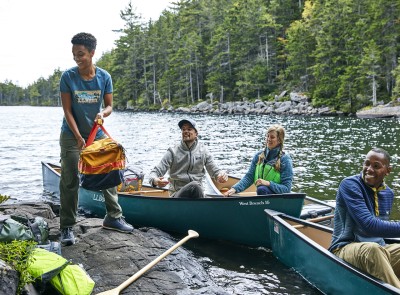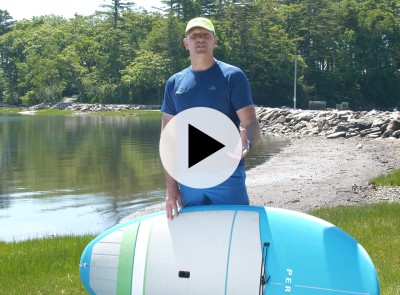(SPEECH)
[00:00:00.00] [BRIGHT MUSIC]
(DESCRIPTION)
[00:00:00.00] L.L. Bean. Parts of the kayak and paddle. Kevin, instructor.
(SPEECH)
[00:00:04.41] So today, we're going to talk about kayaks and also their different parts. Now, there's some different ranges of kayaks. First of all, there's sit-on-tops. Sit-on-tops are really fun because there's no deck or top to the boat, very easy to sit into, there's self-draining and bailing, and just fun to get out on warm waters.
[00:00:21.57] Next up, there's recreational kayaks. Recreational kayaks are great for smooth, protected, flat, calm water. Great to just get out and explore a little bit.
[00:00:31.00] Next up is a light touring range for those who like to get right along the coastline on a calm, protected day. And then you get into sea kayaks, which are made for all conditions. And they can get out and do island hopping and really get you a lot further.
[00:00:43.66] So this is a recreational kayak that we were talking about before, which is great for that flat, smooth waters that you can go on. They are a lot of fun to get in. And one of the things that makes this a recreational kayak is its length.
[00:00:54.78] It's probably 9 to 14 feet in length, about 26 to 32 inches wide. Pretty much a flat-bottomed hull on most of them, so they sit well on that smooth water. They have a big, wide-open cockpit, which is easy to get in and out of.
[00:01:07.69] It might have a few bungees to put a water bottle or sunscreen under, and it may have a compartment for a little bit of storage. So now, we're going to talk about the light touring kayaks. So those are the ones we like to go right along the coast on a smooth water day.
[00:01:20.11] They are about 24 to 26 inches wide. They are about 12 to 16 feet in length. They'll have maybe a little bit of shaping to the hull or somewhat of a flatter hull.
[00:01:30.22] They'll have a cockpit that's smaller than the recreational kayak. So they have a foam wall that's a bulkhead that's in front of your feet and also one behind the seat, some storage compartments, and also some bungees to put some things underneath. So this is a sea kayak. And what makes it a sea kayak are a few different things.
[00:01:46.72] The length of sea kayaks are usually about 15 to 19 feet in length, about 23 and 1/2 inches to 19 inches wide. They have a cockpitted area where you sit that does have that bulkhead, that foam wall in front of your seat and behind your seat, also, different compartments. This one has a day hatch, a stern, and a bow hatch, which is great if you're doing island camping. You put your tent and your gear and supplies in there, the deck bungees and deck lines around the perimeter of the boat.
[00:02:13.12] And some of the sea kayaks will also have a skeg or a rudder for directional stability. So now, we're going to really talk about these parts of the sea kayak here. So as I said, the top surface is the deck. The bottom is the hull. The bow is the front of the boat. The stern is the back of the boat.
[00:02:27.10] And this is the cockpit of the boat, where you sit down. The cockpit coaming is this raised lip around it. You also have a back band, seat and hip pads, and thigh braces. Inside are also foot pegs that you put your feet on.
[00:02:41.02] And this one, this is a carrying toggle on the front here on the bow. There's lines around the perimeter of the boat. Those are called deck line, which is a static line that doesn't have any stretch, which is great if you were in the water to hang on to your boat, opposed to deck bungees that have a lot of stretch, which are great for putting a chart or a water bottle underneath it.
[00:03:00.80] This is an area for a compass. This is a bow hatch of the sea kayak. And what this is is there's a foam wall right here in front of your feet. And this is an airtight, watertightish compartment that's great for storage and to put gear.
[00:03:14.56] As you come back further, you can see more deck bungees, the cockpitted area here. Right behind the seat is another bulkhead, so that foam wall. And then here is a day hatch. So this is storage that you can put things in and also reach it while you're on the water, as opposed to stopping and opening up a bow or a stern hatch.
[00:03:34.06] As we go back further, this is the stern hatch. You have more deck bungees, and then the stern and rear carrying toggle. So next, we're going to talk about parts of a kayak paddle. This one is a take-apart two-piece paddle. So it's a lot easier for convenience when you put it in your car.
[00:03:50.17] When you put the paddle back together, the two ends, where they meet is called the ferrule of the paddle. The long, slender part here is called the shaft of the paddle that we hold on to. So right here where the shaft connects to the blade is the throat of the paddle.
[00:04:02.86] And these are drip rings. The drip rings I put about two or three fingers away from the blade. That will shed water away from you, so it will keep more water off your hands.
[00:04:11.65] And the blades have two faces. There's the power face, which is the spoon side curved upward, and also the back face of the paddle with a raised ridge called the spine down the center of it. You also may notice that they're asymmetrical in shape.
[00:04:25.09] You always want the long edge on top, short edge on the bottom, and the power face faces of the paddler when you paddle. So today, we talked about different types of kayaks and how you'd use them, whether they be sit-on-tops, recreational kayaks, light touring, or sea kayaks. Also, we talked about parts of a kayak and parts of a paddle. So whatever you choose to use, stay safe, have fun. I hope to see you on the water soon.
[00:04:47.44] [BRIGHT MUSIC]
(DESCRIPTION)
[00:04:49.15] Text, L.L. Bean. Be an outsider. A person paddle boards on a sunny day.
[00:04:57.32] With the sun low on the horizon, a hiker leaps up a rock face, with three others following behind her.











